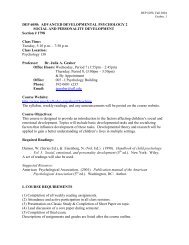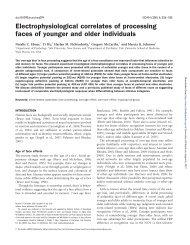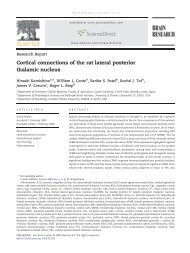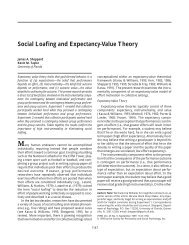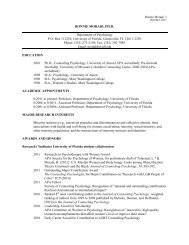Personality theories of successful aging - University of Florida ...
Personality theories of successful aging - University of Florida ...
Personality theories of successful aging - University of Florida ...
You also want an ePaper? Increase the reach of your titles
YUMPU automatically turns print PDFs into web optimized ePapers that Google loves.
<strong>Personality</strong> Theories <strong>of</strong> Successful Aging 93<br />
broad functions: direclf-continuity,<br />
psychodyon;<br />
Bluck & Alea, 2002).<br />
ersations to guide preslving,<br />
developing opin-<br />
Ltction and updating <strong>of</strong><br />
nd promote continuity<br />
; a coherent person over<br />
I to oneself). The social<br />
:veloping, maintaining,<br />
believable and persua-<br />
.nformation about ourwith<br />
others.<br />
and <strong>aging</strong> in multiple<br />
ts a major developmenn,<br />
is characterized by<br />
wing Erikson, wisdom<br />
and negative events <strong>of</strong><br />
rd failures but are able<br />
rsitive aspects <strong>of</strong> their<br />
;this point, one might<br />
on <strong>of</strong> <strong>aging</strong> well. Intert.e.,<br />
turning a negative<br />
h positive events, that<br />
:xt generation in some<br />
levelopment.<br />
story as a milestone <strong>of</strong><br />
it turns out, however,<br />
:o positive functioning<br />
ln (1998), a substantial<br />
rt conceive <strong>of</strong> their life<br />
with their present life.<br />
essible at a given time<br />
formation is more imalso<br />
more likely to be<br />
)leydell-Pearce,<br />
2000).<br />
.. As a consequence/ a<br />
I may no longer be so<br />
rarlier goals, however,<br />
:hological history <strong>of</strong><br />
rute to life narratives<br />
>ver time?").<br />
round their personal<br />
g in life (Little, 1989)<br />
connected behaviors<br />
ted more in the next<br />
rbinding thread that<br />
Itle, 7989; McAdams,<br />
onal goals as Level II<br />
PERSONAL GOALS: PERSONALITY_IN.CONTEXT<br />
From early on, personality psychology has conceptualized goals as building<br />
blocks <strong>of</strong> personality (Freund& Riediger, 2006).In his dynamic theory <strong>of</strong> personality,<br />
Allport (7937, pp.320-321,) regards<br />
motives as personalized systems <strong>of</strong> tensions, in which the core <strong>of</strong> impulse is not tcr<br />
be divorced from the images, ideas <strong>of</strong> goal, past experience, capacities, and style <strong>of</strong><br />
conduct employed in obtaining the goal. Only individualized patterns <strong>of</strong> motives<br />
have the capacity to select stimuli, to control and direct segmental tensions, to initiate<br />
responses and to render them equivalent, in ways that are consistent with, and<br />
characteristic <strong>of</strong>, the person himself.<br />
Personal goals are <strong>of</strong>ten defined as consciously accessible cognitive representations<br />
<strong>of</strong> states a person wants to achieve, maintain, or avoid in the future (Emmons,<br />
1996). They are relatively consistent across situations and over time. Cantor<br />
(1990) suggests locating goals at an intermediate level <strong>of</strong> personality, the level between<br />
"being" G.e., personality traits, basic dispositions) and "doing" (i.e., behavioral<br />
responses in a given situation), a distinction introduced by Allport (7937).<br />
That is, goals are not as broad and comprehensive as personality traits, although<br />
they may be inf luenced by them. They are also not as specific as behaviors. Rather,<br />
they motivate, structure, and direct behavior over time and situations into meaningful<br />
action units (Baumeister, 1991; Emmons, 1986; Ford,7987; Gollwitzer, 1990;<br />
Klinger, 1977) and favor the acquisition and use <strong>of</strong> resources to obtain the goals<br />
(cf. Boesch, 1991; Freund, 2003). Coals can focus attention on those stimuli and actions<br />
in a given situation that are goal-relevant (Bargh & Ferguson, 2000; Gollwitzer<br />
& Moskowit 2,7996; Kruglanski ,7996; Pervin, 1989). As a consequence, they<br />
reduce situational complexity and facilitate interaction with the environment.<br />
As goals are inherently content- or domain-specific, Little (1989) called this<br />
Level II <strong>of</strong> personality the "personality-in-context." According to Little, the notion<br />
<strong>of</strong> personality-in-context is based on the idea <strong>of</strong> an interaction between the person<br />
and his or her environment over time. Personal goals ref lect the interface between<br />
the person's basic personality traits and the specific environment in which he<br />
or she lives. Specifically, the content a goal refers to as well as the goal-related<br />
processes that specify how people select, pursue, and disengage from goals are<br />
crucial in this regard. Addressing the issue <strong>of</strong> <strong>successful</strong> development and <strong>aging</strong><br />
in the present context, we do not focus on the content <strong>of</strong> goals (see Freund & Riediger,2006,<br />
for a recent overview) but on the motivational processes that accompany<br />
and underlie goal-related processes and their relations to <strong>successful</strong> development.<br />
DpprrvrNc CoNrExr<br />
Context can be broadly defined as the set <strong>of</strong> circumstances that surrounds a<br />
person, such as culture, historical time, family, social relations, and geographical<br />
environment. It does not only serve as a background for the behavioral expression <strong>of</strong><br />
personality, but also plays an important role in shaping personality. Cultural, social,<br />
or geographic conditions may represent limitations as well as chances and opportunities<br />
in that they exclude or allow certain possibilities <strong>of</strong> whether and how a person<br />
can express his or her basic personality traits. For example, growing up with older<br />
siblings may render a person more agreeable because only by being more agreeable





